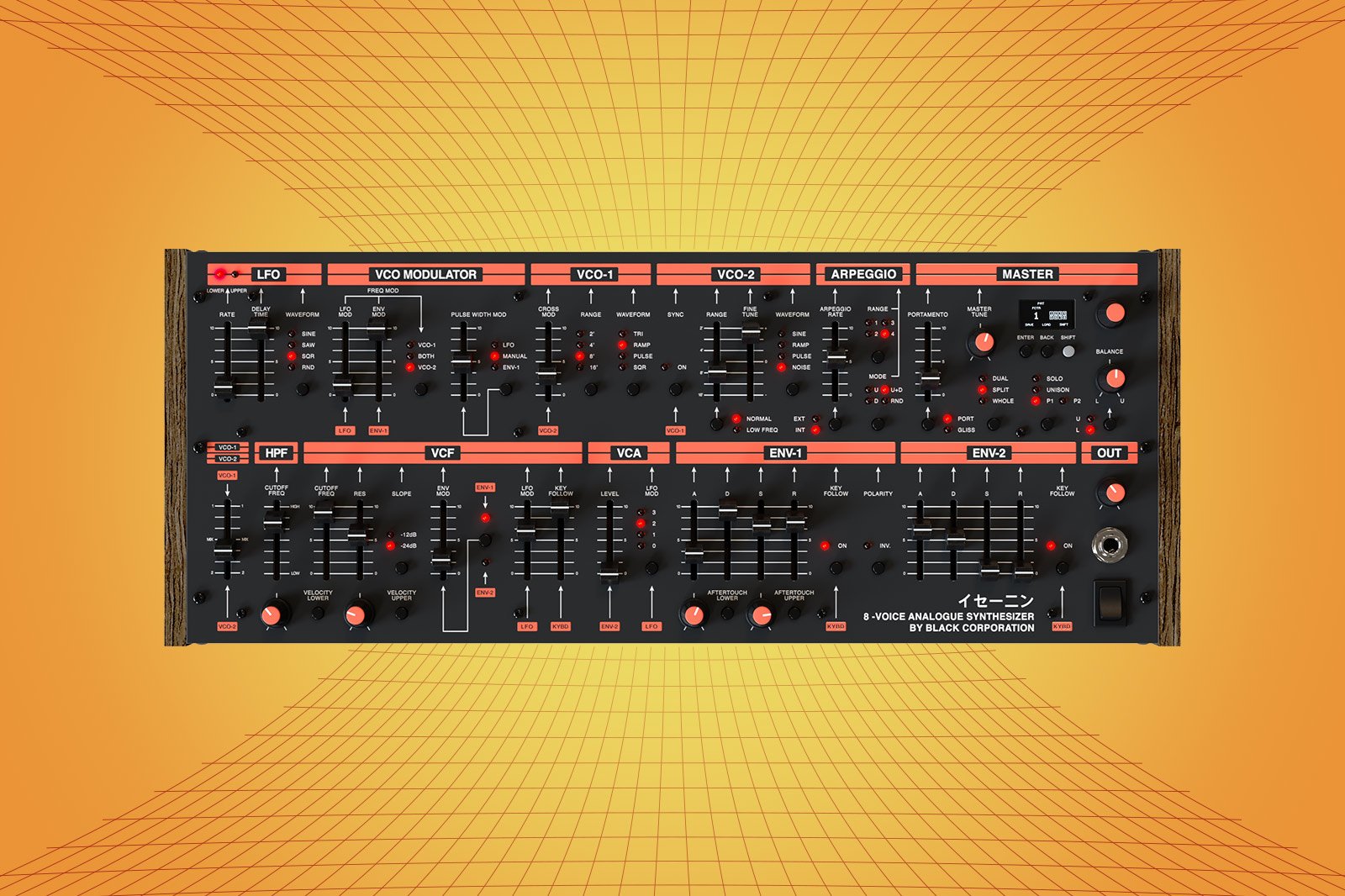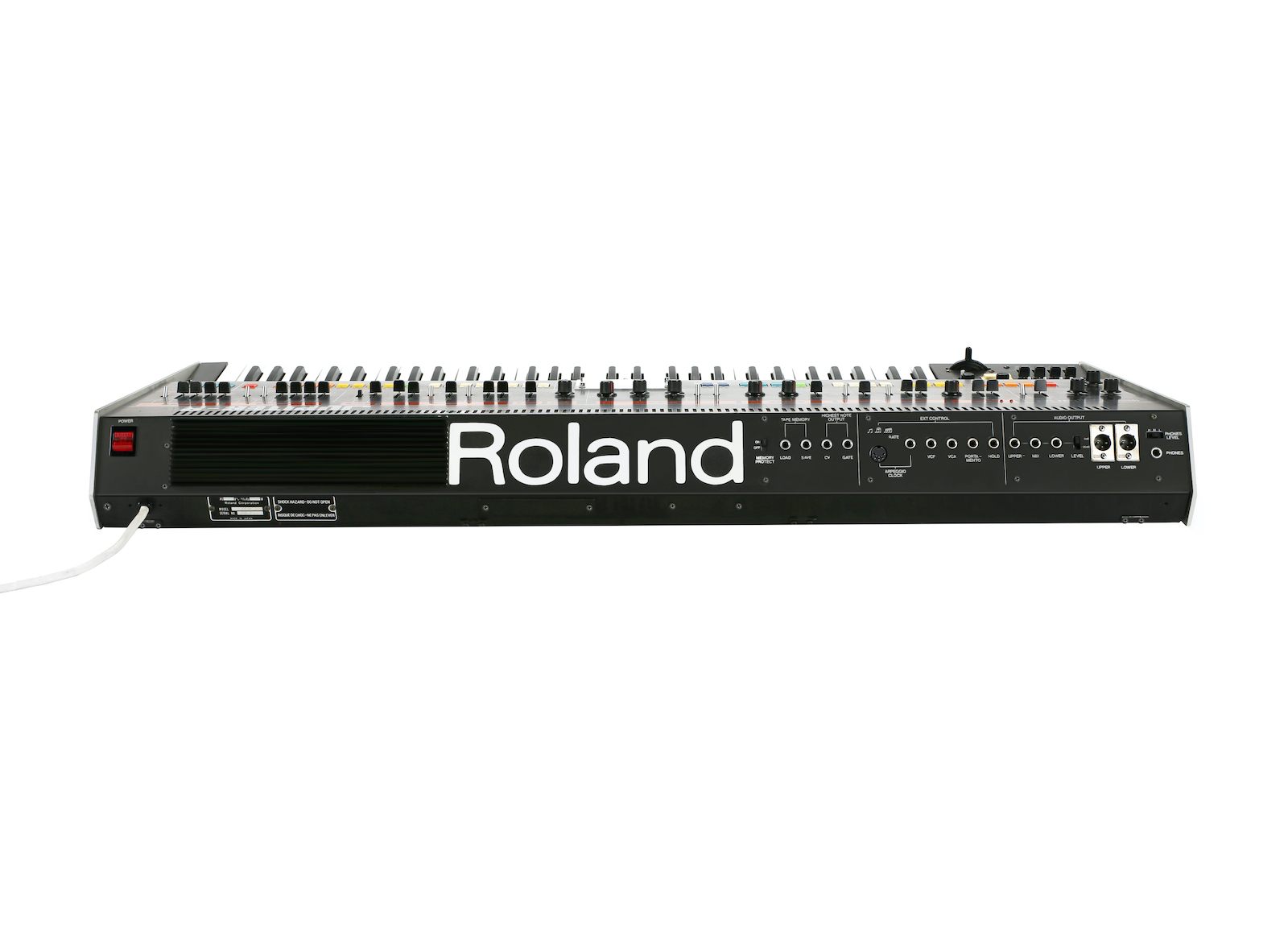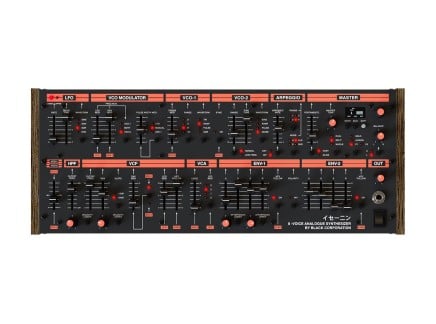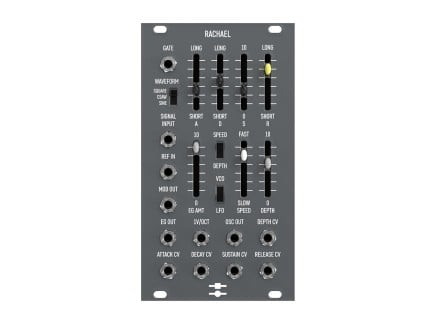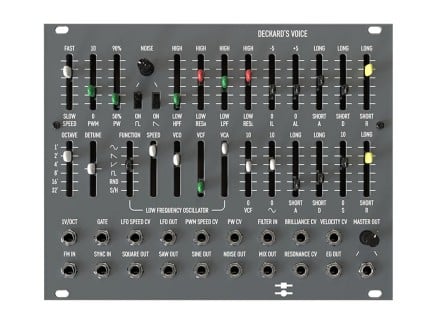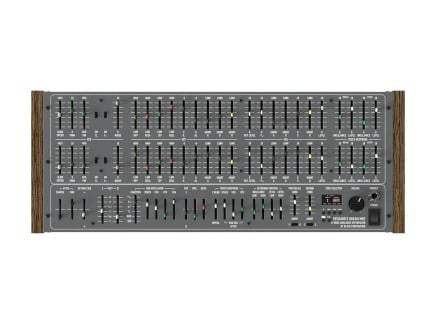After a lengthy development period, ISE-NIN, Black Corporation's homage to Roland's Jupiter-8, is finally here! The latest synthesizer from a company dedicated to putting out modern reimaginings of iconic instruments, ISE-NIN is probably the most anticipated Black Corp. instrument since the CS-80-inspired Deckard's Dream. And for good reason—the Jupiter-8 easily sits among the pantheon of legendary synthesizers, making appearances on numerous hit records from Michael Jackson, ALicia Keys, Duran Duran, and more.
Because their sound and parameterization are so similar, it's hard to talk about the ISE-NIN without briefly covering the Jupiter-8's history and features. As such, we'll go over why the Jupiter-8 earned its place in the synthesizer hall of fame, before turning over to the ISE-NIN and highlighting the things that make it special and exciting.
We'd also like to mention that, at the time of publishing this article, we currently have one extremely limited-edition ISE-NIN on hand, dressed out in the blue and yellow colors of the Ukrainian flag. We're offering this instrument on the behalf of Black Corporation, with the additional proceeds of the increased price going towards non-military charity efforts in Ukraine. This ISE-NIN is just one of five that will ever be made, making it quite a unique collector's piece while also supporting incredibly important causes during the ongoing war.
Roland's Original Flagship Keyboard: Jupiter-8
In the early days of synthesizers, Roland quickly established themselves as a powerhouse manufacturer of instruments for electronic music, and keyboard synths were no exception. We've already talked at length about the Juno series, but we're long overdue for some attention on Roland's flagship line of keyboard synthesizers. Specifically in the context of the new ISE-NIN, our focus will be on the Jupiter-8—the one considered by many to be the best synthesizer produced, not simply by Roland, but of all time.
By the late 1970s, analog synthesizer production was a fast-paced race of development and innovation, especially as polyphony became a managable prospect. Following instruments like Yamaha's CS-80 and Sequential Circuits' Prophet-5, Roland sought to ensure that their own flagship keyboard synthesizer delivered a balance of cutting-edge features, ease-of-use, and, most importantly, great sounds. As a result, when the Jupiter-8 finally hit the market in 1981, it was another monumental step towards establishing Roland as one of today's biggest names in the synthesizer world.
As far as its synthesis capabilities are concerned, the Jupiter-8 is a fairly standard but great sounding instrument. Two analog VCOs in each of its eight voices allow for detuning, waveform layering, hard-sync, and even cross-modulation, with further timbre shaping available via the highpass and resonant lowpass filters. Add in the dual LFOs and envelope generators, and the Jupiter-8 is a delightful take on a subtractive-style polysynth—and it's one that's so easy to use, thanks to its clear panel layout.
But in our eyes, the magic of Jupiter-8 isn't just from its raw sound capabilities, but also from the performance features and controls that Roland built into it. Following in the footsteps of the Prophet-5, the Jupiter-8 makes use of a microcontroller to store presets into digital memory, which may then be recalled with the colorful buttons on the right. 64 presets, arranged into eight banks of eight presets each, offer enough room for you to keep plenty of your favorite Jupiter sounds within reach.
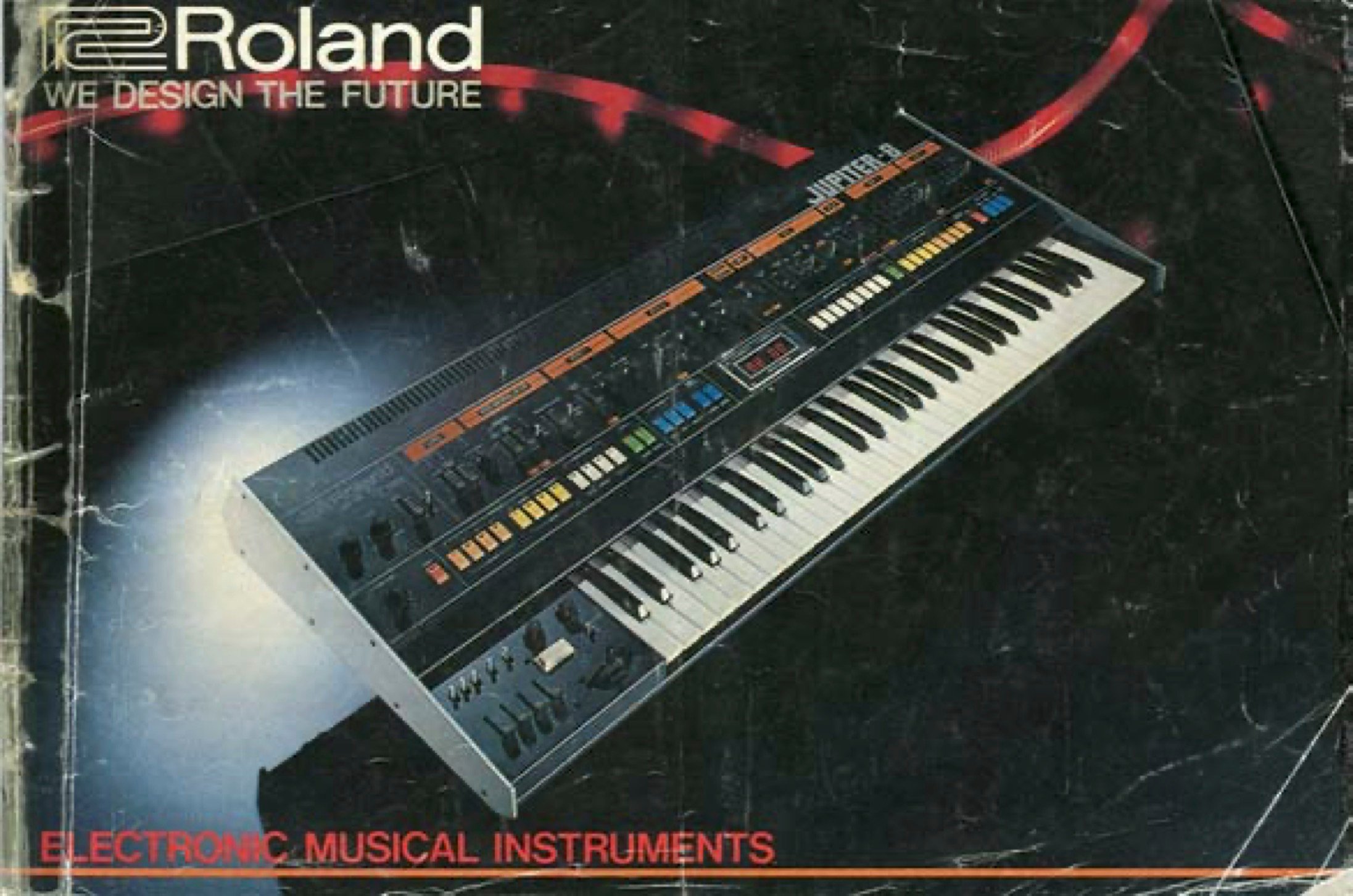 Jupiter-8 featured on the cover of Roland's 1981 Product Catalog
Jupiter-8 featured on the cover of Roland's 1981 Product Catalog
Also borrowing a page from the CS-80, the Jupiter-8 is a bi-timbral synthesizer, meaning it's possible to split its eight voices into two four-voice parts. This can be done either by setting up a keyboard split at middle C or layering both sounds across the full keyboard—either way, each layer is capable of running its own preset. But unlike the behemoth CS-80, Jupiter-8 doesn't offer identical sets of controls for its layers, instead using Panel Mode switches to toggle between the Upper and Lower layers. Though this means only one layer is accessible from the front panel at a time, setting one layer to a solid preset and the other to manual mode for performing tweaks as you play is super fun way to play the Jupiter-8.
We've specifically mentioned the CS-80 and Prophet-5 a few times in this article now, but by no means are we suggesting that the Jupiter-8 is simply a derivative design or copycat of other successful instruments. Instead, we want to point out an interesting nuance in how products like this come to be. New and innovative ideas are one thing, but it's another thing entirely to combine ideas in useful and intuitive ways. There's no doubting that the Jupiter-8 has its own unique sonic character, but Roland's ability to package desirable features and functions in a way that's actually useful to the end-user is perhaps more important than the features themselves. And if the list of hit records that feature the Jupiter-8 is any indication, Roland's design team played their cards right.
But that's enough talk of past synthesizers—let's move onto the latest take on the Jupiter sound: ISE-NIN.
The Modern Jupiter-8: ISE-NIN
Much like how the other instruments in the Black Corporation family remain faithful to the sounds of the iconic synthesizers that inspired them, ISE-NIN is a highly convincing take on the Jupiter-8 at a fraction of the size (and cost, believe it or not). But while staying true to the sound and aesthetics of the original, Black Corporation also takes the opportunity to pack in modern features to bring these sounds to the present day in a way that actually makes sense for contemporary musicians and studios.
Even if you've never used Jupiter-8 or any of its many software emulations, ISE-NIN is an effective homage to the clear layout of Roland's original. Its recreation of the original orange and black panel leads you to each and every element of the sound path, and the distinct labeling and use of arrows ensures that you always know which slider or button controls which parameter. Of course, preset management has come a long way since 1981, and ISE-NIN foregoes classic rainbow buttons for the encoder and display screen found on other Black Corp. synths. This has the advantage of drastically increasing the number of preset memory slots, up from the Jupiter-8's modest 64 to a whopping 1280 across 10 banks of 128 presets.
Among the most important differences from the original Jupiter-8, ISE-NIN offers a robust MIDI specification. This seems obvious in today's day and age, but remember that MIDI did not yet exist at the time of the Jupiter-8's development and release. And like the other Black Corp. synths, ISE-NIN supports MIDI Polyphonic Expression (MPE) and everything that comes along with it: polyphonic aftertouch, per-note pitch bends, per-note control changes, and more. This includes the bitimbral dual and split modes as well, meaning that you're able to push any classic Jupiter-8 sound into fresh and expressive new directions—I'm personally looking forward to someone pairing ISE-NIN with Expressive E's Osmose.
ISE-NIN is the first Black Corporation instrument with extensive support for alternative and micro tunings, extending its musical vocabulary outside of western music's predominantly 12-tone equal temperament structures. For remarkable ease of use, ISE-NIN handles this via support for the ODDSound MTS-ESP suite, a collection of software tools that provide flexible and immediate re-mapping of notes into scales and tuning systems like just intonation, 19-notes per octave, and more. While this might not be a feature that everyone needs, it's a valuable tool to have on hand for film scoring or other musical scenarios where a dash of experimental flair is just the spice you need.
A Legendary Sound, Available Once Again
Given how much of a hit Black Corporation's Deckard's Dream synthesizer has been, we're sure that ISE-NIN is just the thing that the most passionate of Jupiter-8 fans have been waiting for. Admittedly, ISE-NIN is a significant financial investment, but well under the asking price for a well-maintained Jupiter-8. And when you consider its small size, modern features, and the way it nails the Jupiter-8 sound, ISE-NIN is almost certainly going to find its way into studios that will appreciate it.

